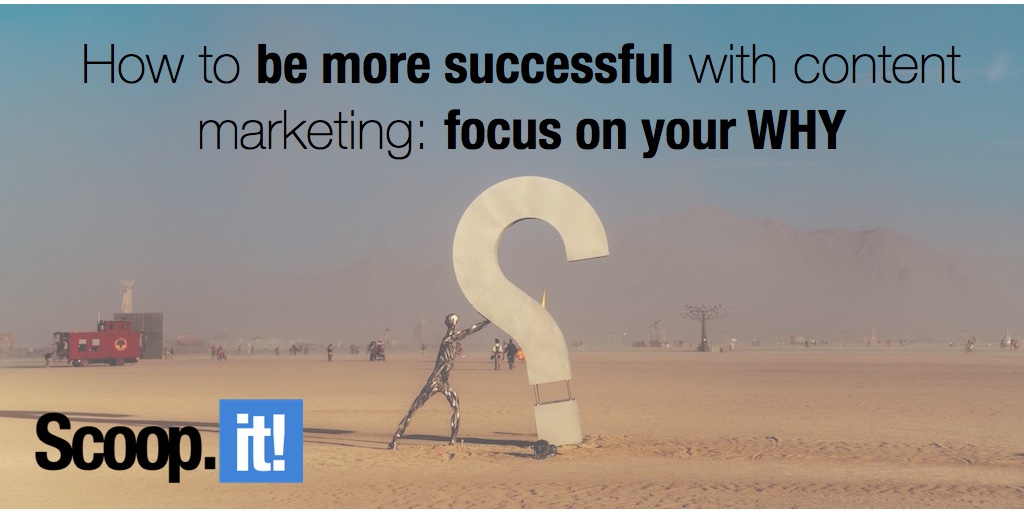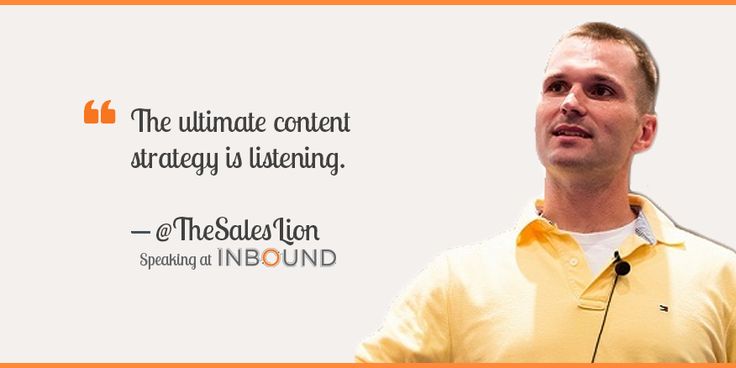
“Why you exist is not your product. Your why is the problem your product solves.”
Read the full article here.
In this thought provoking article, content marketing expert Joe Pulizzi discusses the challenge of creating good content that delivers value to the audience, and the rampant problem of self-promotional content that is resource-exhausting and ineffective. Instead of creating content that drives the organizational goals of the business, marketers need to instead shift their primary focus to the wants and needs of the audience. In order to be more successful, content marketers need to remember WHY their product exists in the first place: and from there generate content dedicated to addressing how their product specifically solves the problems of their audience.
This is an inspiring article that led me to think critically about how the ‘why’ approach is a powerful way to drive action and behavior in areas beyond content marketing (like effective leadership, as in Simon Sinek’s TED talk ‘Start with Why’ on how great leaders inspire action). Here are some ways to create better content that resonates with your audience by focusing on your why rather than on your what.

WHAT your content shouldn’t be: that guy who talks about himself
One of the biggest problems with most content today is that it’s saturated by self-promotion, focusing on the brand or product rather than on the audience it aims to reach. This is a huge deal breaker for any audience. Just like on a first date or any situation where you’re meeting and interacting with people: no one wants to hear you talk about yourself. Don’t make your content be that guy. Overly-promotional content is impersonal and a turnoff, and people will immediately tune out and become disinterested.
Here are some tips to help you stay aligned with your ‘Why’ and to help you create more meaningful content for your audience:
Audience first, business second
One of the core tenets of content marketing is understanding and writing specifically for your audience. According to Marcus Sheridan, “You can’t reach the business goal without first serving the needs of the audience.” Of course this isn’t to say you should discount the objectives of your business, but you can’t expect to elicit any kind of desired action from a potential customer without first building a relationship and establishing trust. Content that puts the business first and audience second is impersonal, self-promotional and won’t get you anywhere. On the other hand, effective content that is educational and built on how to improve the lives of your audience will launch you on a path to achieving your business goals.
Find out what your audience wants
In the quest to create valuable content for your audience, we as content marketers need to make our fundamental goal to identify the needs and pain points of our audience and from there show them directly how we can solve them. In order to do this effectively we need to do a little digging and perform some basic detective work with a touch of psychology.

Talk to them: what better way to understand your target audience than by pro-actively communicating with them directly? This means talking with them in person, surveying them, and monitoring social networks and online communities in your niche to keep track of their most frequently asked questions and challenges.
Listen to them: good content is founded on having first taken the time to listen to the biggest problems and challenges facing your audience.
Rather than take the time to find out what the audience is saying, marketers often skip this step entirely and go directly to creating impersonal, self-promoting content that offers the audience nothing.
Answer their questions: the basis of all your content should be founded on listening to your audience and addressing their top questions and concerns.
Establish a mission statement on which to base the direction of your content
A common mistake many marketers tend to make is jumping directly into creating content without having clearly defined goals and objectives. Content marketing is a cycle that begins with strategy. Even if you set out intending to put the audience at the heart of all the content you produce, it’s easy to lose sight of this and regress to creating promotional content without having properly strategized your content from the very beginning. Start by creating a mission statement that focuses first on the needs of the audience and second on how the product will help to solve those needs. Then tailor each piece of content to your audience personas.
Show rather than tell
If you’ve done your research and Sherlock Holmes’d your way into identifying your audience’s biggest problems, great job. Now you need to connect the dots for your audience and show them how your product can help. Telling them that your product does something is meaningless unless you can show them how it will directly impact and improve their lives.
Monitor your content’s performance with analytics
To ensure your content is valuable and relevant to your audience, you need to consistently monitor its performance. A content marketing analytics framework like this is great for making sure you know what types of content are working and what aren’t so that you can continually improve.
And if you want to find out how to generate more leads with content marketing, including ways to re-purpose your content into other forms, insights on which formats to focus on and techniques to measure results, download this free eBook:
Image by Galen Oakes.




Very often people don’t buy a good story for itself. They buy what they see and what is heavily advertised. There are thousands of very good stories buried in the depths of Amazon while some garbage sell like crazy. Without advertising in a way or another there is almost no chance to get noticed because novels are published by hundred of thousands or even more.
Well… Isn’t the whole success of content marketing demonstrating just the opposite? Sure, distribution is important but content marketing shows that good content sells.
I agree that it takes more than simply being articulate or endowed with stellar storytelling abilities to succeed in content marketing. I’m merely suggesting that marketers assume a different approach in their content whereby they are reminded of the original purpose of what they are selling in the first place, which has to do with addressing the needs of the customer. This is a larger philosophical concept that demonstrates the importance of staying grounded and connected to an original purpose or idea- I’m not saying this alone warrants success- this of course is only a component and of course distribution… Read more »
Thank goodness someone is promoting quality content. I often struggle with myself: do I post something on my blog to post something, or wait to post something worth saying.
digital marketing training
It’s one of the struggle I had when considering to start a blog 5 years ago. And as I realized I didn’t want to post sub-standard content for the sake of posting, I felt curating other people’s content was a great way to alleviate this: still offering valuable content to my audience with my own insights but without the need for inspiration, research and… the 4 hours it takes me to blog. And so I didn’t start a blog but we started Scoop.it instead.